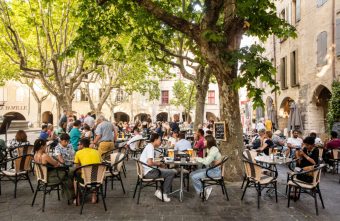Let us tell you a bit about this stone giant…
An exceptional and preserved historic heritage
The Pont du Gard was built by the Romans in the first century. It’s not actually a bridge, it is the remains of an aquaduct that, for five centuries, used to transport water from the Eure source in Uzès to Nîmes. The 35,000 m3 of water carried by the aqueduct every day would supply the residents of the town with drinking water, and there was still enough left for the baths, fountains and gardens across the town.
Standing at 50 metres high over three levels, it is the highest antique aqueduct-bridge in the world! It is a real symbol of Roman scientific genius, with a length of 52 metres and only descending in height by 17 metres over the entire length. The builders of that time were highly skilled to have been able to build the bridges and tunnels to Nîmes, across this scrubland. Today, it is the only ancient bridge with three levels that is still standing!
Throughout the centuries, the Pont du Gard has been a source of inspiration for many artists: some great names in literature such as Rabelais, Rousseau, Stendhal, Dumas and Mérimée described the rather special beauty of this place.
“This monument, that was but a simple aqueduct, stands majestically in the midst of the most profound solitude. The soul is thrown into a profound sense of amazement. I’m not sure that even the Roman Coliseum put me into such deep a trance.” Stendhal, Memoirs of a Tourist (1854).
Since the 16th century, the Pont du Gard has undergone regular restoration and preservation work. In 1840, it was listed as a Historic Monument, in 1985 it was added to Unesco’s list of World Heritage Sites, and in 2004 it was awarded the “Grand Site de France” label. The purpose of these labels is to make sure this, the most visited ancient monument in France, is protected and kept in good condition. Today, only pedestrians can access the monument.
Are you a history buff?
In that case, we can tell you a bit more about the Pont du Gard! The first level, the part you can walk along, was only added to the ancient monument in 1747, by Henri Pitot, engineer from the Age of Enlightenment and native of Aramon, in our region. His childhood home is next to the church in Aramon. Henri Pitot is also well-known for having designed the aqueduct in Montpellier, which carried water from the Lez source to Peyrou water tower in the town centre, and the majestic arches known as “Les Arceaux” are often compared to our own Roman aqueduct.
When you cross the Pont Pitot, take the time to look at the many markings engraved into the stone. Between 1611 and 1989, the “Compagnons du Tour de France” craftsmen would come to admire this architectural gem, and engrave their marks and tools here.
And what about the aqueduct channel? To see it, you’ll have to go up to the third level, up the steps on either side of the monument. You’re in for a unique and rather atypical experience, at a height of exactly fifty metres off the ground! You’ll find yourself full of emotion and standing right in the middle of the long channel that would carry water all the way to Nîmes. Enjoy the view from up there, it’s breath-taking!
 Ticketing
Ticketing  Pass
Pass
 Gift box
Gift box  Groups & business
Groups & business 















